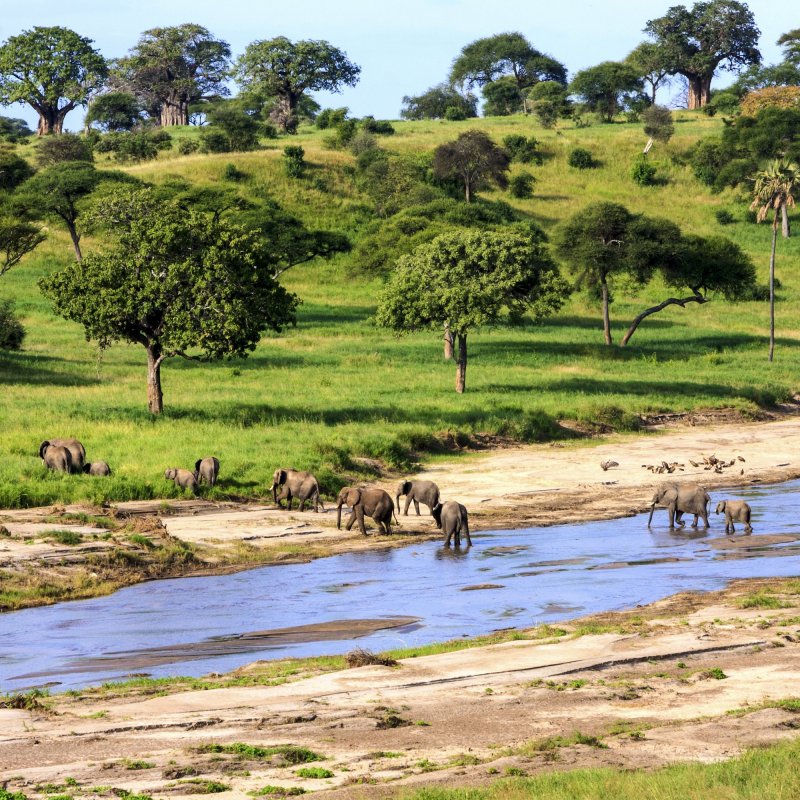
Africa is a vast continent, and if you are planning a trip there, you may well be wondering where to go and which of the hundreds of national parks and game reserves to choose from. Help is at hand.
Videos by TravelAwaits
Here, I weigh in on the top 10 parks and reserves per a safaribookings.com report that takes into account the reviews of 2,300 tourists and 1,000 African travel experts — and share what you can expect to see when you get there based on my decades of safari experience.
1. Serengeti National Park, Tanzania
Coming in at number one is Serengeti National Park, in northern Tanzania. The Serengeti shares a border with Kenya’s Maasai Mara National Reserve (which we will chat about more when you reach the number 10 spot on this list). Serengeti’s sprawling grasslands make for those classic safari views with flat-topped acacia trees and grazing herds of zebra and antelope. These grazing herds attract large numbers of predators, and the open plains make for a fantastic destination to watch lions and cheetahs in action.
The Serengeti is also home to the annual Great Migration, in which over one million wildebeest and hundreds of thousands of other ungulates make their over-600-mile circular trek. The animals travel from their breeding grounds in the south to fresh pastures in the north, all the while with predators hot on their heels. The Great Migration is one of the most impressive natural events in the world.
As an exciting and special bonus, black rhinos were reintroduced into the Serengeti, some in 2010 and more in 2019, and earlier this year, a black rhino calf was born to one of the reintroduced females — the first black rhino birth in the park for decades.
Nomad Tanzania has the beautiful Serengeti Safari Camp which is the perfect location to catch the wildebeest migration.

2. Mana Pools National Park, Zimbabwe
Next on our list, we have Mana Pools National Park in the far north of Zimbabwe. The Zambezi River’s wide waters form the boundary between Zimbabwe and Zambia. On the southern Zimbabwean side is Mana Pools National Park, a stunning UNESCO World Heritage Site and a park known for fantastic wildlife visibility beside the river and flood plains. (On the northern bank is Zambia’s Lower Zambezi National Park, which we will focus on when we reach number 5 in our countdown).
Mana is the Shona (local language) word for four, and within the park, the river channels have created four large pools, giving the park its name. These pools are surrounded by forests of mahogany, wild fig, ebony, and winter thorns. In the dry season, the shady glades beneath these trees are filled with wildlife — herds of impala, eland, elephant, zebra, buffalo, waterbuck, and kudu. These animals provide a plentiful supply of prey for both predators and scavengers. There are several sizable prides of lion as well as leopards and hyenas. Mana Pools is also a stronghold for wild dogs.
Mana Pools National Park is the perfect place for walking and canoeing safaris. David Attenborough’s wildlife series for the BBC, “Dynasties,” filmed the episode about wild dogs in the park. I have spent hours watching these same wild dogs and I can promise you the park is the perfect place to go to spot this endangered African animal.
African Bush Camps have three fantastic lodges in Mana Pools, each in a different park area.

3. MalaMala Game Reserve, South Africa
MalaMala is the oldest and one of the largest private Big Five game reserves in South Africa. It covers 37 000 acres, shares a 12-mile unfenced boundary with the world-renowned Kruger National Park, and is sandwiched in a prime position between the Kruger and the Sabi Sands Reserve, giving it great access to abundant wildlife.
In the local language, Xitsonga, the name Malamala means Kudu, and the area got its name from the abundance of these majestic, spiral-horned antelope within the game reserve. The reserve is also home to the Big Five and is famous for luxury photographic safaris.
MalaMala is the place to start your search for accommodation within the reserve.

4. Okavango Delta, Botswana
The Okavango Delta is a vast inland river delta in northern Botswana. The area is known for its sprawling grassy plains, which flood seasonally, becoming a lush animal habitat. The delta supports an astonishing variety of wildlife. The best time to visit is during the annual flood, when many of the animals are confined to islands created by the floodwaters, making them easier to spot. Highlights include great herds of elephant and antelope, hippos, crocodiles, lions, and cheetah. Many of the birds spotted here are endemic.
The most exciting way to explore the area is by traditional dugout canoe (mokoro), which I first did in my early twenties, navigating past hippos, elephants, and crocodiles, and spending several nights camping on tiny islands. About 40 percent of the Okavango Delta is in the Moremi Game Reserve, on the eastern edge of the Delta, and we will focus on that when we reach number 6.
Very much the center of Botswana’s safari industry, the Okavango Delta features some of Africa’s premier camps. A good place to start your accommodation search is with Wilderness Safaris who has several beautiful luxury lodges in the Okavango Delta.

5. Lower Zambezi National Park, Zambia
If you follow the Zambezi River about 300 miles downstream of the Victoria Falls, opposite Zimbabwe’s Mana Pools, you will find the pristine wilderness of Zambia’s Lower Zambezi National Park.
An area of abundant wildlife, from herds of elephants to soaring fish eagles and everything in between. A hunting ground for lions, leopards, and wild dogs. A timeless valley of giant towering winter thorns where wildlife finds sanctuary in the dappled shade. The area’s beauty lies in its wildness and the spectacular opportunities to get up close to the game that wanders in and out of the Zambezi’s channels.
The river is home to hippos and crocodiles and is the perfect place for sunset boat trips, trawling for the coveted tiger fish, and one of my favorite activities, canoeing safaris. I have traveled the length of the Lower Zambezi National Park by both road and river, and can highly recommend this beautiful park.
Anabezi has three fantastic lodges along this stretch of the river and is a great place to start planning your trip.

Sarah Kingdom
6. Moremi Game Reserve, Botswana
Coming in at number six, Moremi Game Reserve is a protected wildlife area in Botswana. It lies on the Okavango Delta’s eastern side and was named after Chief Moremi of the BaTawana tribe. Moremi was designated as a game reserve, rather than a national park, when it was created, which meant that the BaSarwa or Bushmen who lived there were allowed to remain in the reserve. Among other animals, the reserve is home to cheetah, white and black rhinoceros (rarely seen), wild dogs, lions, and over 500 bird species. This ecosystem is amongst the richest in Africa.
Island Safari Lodge is an ideal jumping-off point for a trip into Moremi, and they also offer fantastic mobile safaris into the reserve, which I have done with my family and thoroughly enjoyed. Let this small but diverse area blow you away with its wildlife.

7. South Luangwa National Park, Zambia
In eastern Zambia, South Luangwa National Park plays host to huge concentrations of wildlife, including elephant, buffalo, lion, giraffe, hippo — over 450 species of bird and 60 species of mammal! South Luangwa is also arguably the best place in Africa to see leopards.
South Luangwa is known for incredible walking safaris that give you the chance to get up close to the park’s wildlife. There is something incredibly special about a safari on foot — no noise from vehicles, just the crunch of dry grass underfoot. Your senses are heightened; you see and hear things that you have never noticed before. You become conscious of how loud your breath sounds in your ears as you try hard to walk silently through the bush. For an expertly guided walking safari in South Luangwa, you can’t go wrong with Surefoot Safaris.

Sarah Kingdom
8. Ngorongoro Crater, Tanzania
The Ngorongoro Crater formed when a giant volcano exploded and collapsed in on itself two or three million years ago, creating a crater 2,000 feet deep and a 64,000-acre floor. The Ngorongoro Crater is home to an exceptional concentration of fauna; it is estimated that over 25,000 large animals live here (I’m not including birds, insects, or reptiles in this count!), including huge herds of wildebeests and zebras. There is also no shortage of predators, with the crater being home to lion, hyena, cheetah, jackal, caracals, bat-eared foxes, and more. A definite highlight is the healthy population of black rhino and some of the largest tusker elephants on the continent. The lake at the center of the crater hosts huge flocks of rose-colored flamingos, while Maasai tribespeople still live within the conservation area.
Given its size, the Ngorongoro Crater really only needs a day or two of your travel time, and is best as part of a larger East African itinerary, perhaps combining the wildlife wonders of the Crater w with the migration spectacle of the Serengeti or the laid-back beaches of Zanzibar. I often take a day trip to Ngorongoro as a break at the end of a Kilimanjaro climb.
As a taste of luxury, perhaps try Ngorongoro Crater Lodge for a special visit to this fantastic place.
9. Sabi Sand Game Reserve, South Africa
The Sabi Sands Game Reserve is a 160,000-acre reserve pioneered by local landowners in the 1950s and shares a 31-mile-long unfenced border with the world-renowned Kruger National Park. Known for delivering excellent Big Five game viewing, with some extraordinary close encounters and prolific sightings, particularly of the elusive leopard, this area is considered one of the best safari areas in South Africa.
Sabi Sands offers a variety of accommodation options to suit everyone and every budget. As there are several lodges to choose from in the game reserve, visit Sabi Sands to start planning your trip.

10. Masai Mara National Reserve, Kenya
Last but not least, and located in the extreme southwest of Kenya, on the border with Tanzania, is the Maasai Mara National Reserve. Covering over 580 square miles, this quintessential safari destination is home to the Big Five and is famous for its thriving big cat populations. Special Maasai Mara experiences include hot air balloon safaris, visits to local Maasai villages, and of course, the Great Migration, which is when the Mara is a pit stop for almost two million wildebeest, zebra, and antelope crossing from Tanzania across the mighty Mara River on their death-defying, 1,800-mile circular journey. In fact, these herds are so big they can be observed from space.
The Maasai Mara is a photographer’s paradise, with year-round game viewing, incredible big cat sightings, and large concentrations of elephant, buffalo, and giraffe. Governors’ Camp was the first permanent tented camp in the Masai Mara, and it occupies some of the best wildlife viewing locations in the reserve.
There is nothing quite like the thrill of an African safari. The stillness of the early morning, before the heat of the sun covers the land. The sound of wild creatures calling in the night. The sense of adventure that comes from being surrounded by untamed wilderness. Above all, it’s the excitement of being in the bush, never quite knowing what new sights, sounds, and experiences the day will bring. I’ve given you a tiny taste of 10 of the most popular safari destinations on the continent. Choose one of these for your next African adventure and you won’t be disappointed.
Related articles:
